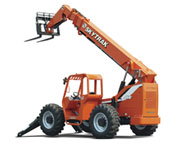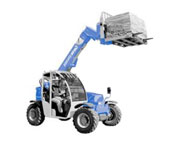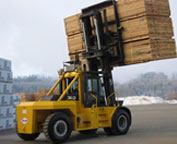
Forklift Brakes - A brake in which the friction is provided by a set of brake shoes or brake pads which press against a rotating drum shaped unit referred to as a brake drum. There are a few specific differences among brake drum types. A "brake drum" is commonly the definition given whenever shoes press on the inner outside of the drum. A "clasp brake" is the term used so as to describe whenever shoes press next to the outside of the drum. One more type of brake, called a "band brake" uses a flexible belt or band to wrap around the exterior of the drum. If the drum is pinched in between two shoes, it can be called a "pinch brake drum." Similar to a conventional disc brake, these kinds of brakes are rather uncommon.
Early brake drums, prior to the year 1995, needed to be constantly modified to be able to compensate for wear of the drum and shoe. "Low pedal" can cause the required modifications are not carried out sufficiently. The vehicle can become hazardous and the brakes could become useless if low pedal is mixed along with brake fade.
There are quite a few various Self-Adjusting systems used for braking offered nowadays. They can be classed into two separate categories, the RAI and RAD. RAI systems are built-in systems which help the tool recover from overheating. The most well known RAI makers are AP, Bendix, Lucas, and Bosch. The most famous RAD systems consist of Volkswagen, VAG, AP, Bendix and Ford recovery systems.
The self adjusting brake would usually only engage if the lift truck is reversing into a stop. This method of stopping is satisfactory for use whereby all wheels utilize brake drums. Disc brakes are used on the front wheels of motor vehicles today. By working only in reverse it is less likely that the brakes would be applied while hot and the brake drums are expanded. If adjusted while hot, "dragging brakes" can occur, which increases fuel intake and accelerates wear. A ratchet tool that becomes engaged as the hand brake is set is another way the self adjusting brakes could work. This means is only suitable in functions where rear brake drums are used. Whenever the parking or emergency brake actuator lever goes over a specific amount of travel, the ratchet advances an adjuster screw and the brake shoes move toward the drum.
Placed at the bottom of the drum sits the manual adjustment knob. It can be tweaked using the hole on the other side of the wheel. You would have to go under the vehicle along with a flathead screwdriver. It is really significant to adjust every wheel evenly and to be able to move the click wheel properly in view of the fact that an uneven adjustment may pull the vehicle one side during heavy braking. The most efficient method to be able to guarantee this tedious task is done carefully is to either lift each and every wheel off the ground and hand spin it while measuring how much force it takes and feeling if the shoes are dragging, or give everyeach and every one the same amount of clicks using the hand and then perform a road test.
![]() Click to Download the pdf
Click to Download the pdf
Forklift Parts








Lift Parts Express
TOLL FREE: 1-888-695-7994
forkliftpartsyukon.com
Email Us
About Us



